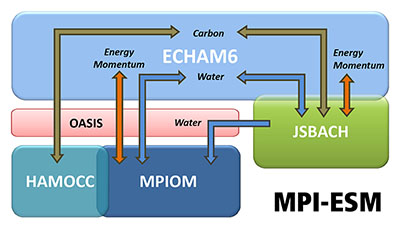The Earth system model MPI-ESM is based on the following model components: ECHAM6 (atmosphere), MPIOM (ocean physics), JSBACH (terrestrial biosphere) and HAMOCC (ocean’s biogeochemistry). A separate coupling program, OASIS3, establishes the link between the different components, in which energy, momentum, water and CO2 can be exchanged.
 This new model, as compared to ECHAM5/MPIOM (Hamburg’s IPCC-AR4 Model), was extended in order to simulate the carbon cycle and its interactions with the physical climate system.
This new model, as compared to ECHAM5/MPIOM (Hamburg’s IPCC-AR4 Model), was extended in order to simulate the carbon cycle and its interactions with the physical climate system.
Depending on the experiment, the model was set to use different spatial resolutions.
T63L47/GR15L40 (“LR” - Low Resolution)
• Atmosphere: approximate horizontal resolution of 200 km (1.875 degrees) at 47 layers (up to 0.01 hPa / 80 km in height)
• Land biosphere (interactive vegetation): same horizontal resolution as atmosphere
• Ocean including biogeochemistry: horizontal resolution varies from 12 to 150 km at 40 layers
T63L95/TP04L40 (“MR” - Mixed Resolution)
• Atmosphere: approximate horizontal resolution of 200 km (1.875 degrees) and higher vertical resolution of 95 layers (up to 0.01 hPa / 80 km in height)
• Land biosphere (interactive vegetation): same horizontal resolution as atmosphere
• Ocean including biogeochemistry: horizontal resolution varies from an average of 0.4 degrees (40 km) at 40 layers
More Information:
Information about the Max Planck Institute for Meteorology's Earth system model MPI-ESM (pdf, only available in German)
